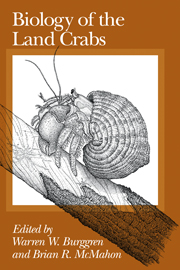Book contents
- Frontmatter
- Contents
- List of contributors
- Preface
- 1 BIOLOGY OF THE LAND CRABS: AN INTRODUCTION
- 2 EVOLUTION, SYSTEMATICS, AND GEOGRAPHICAL DISTRIBUTION
- 3 ECOLOGY
- 4 BEHAVIOR
- 5 REPRODUCTION AND DEVELOPMENT
- 6 GROWTH AND MOLTING
- 7 ION AND WATER BALANCE
- 8 RESPIRATION
- 9 CIRCULATION
- 10 ENERGETICS AND LOCOMOTION
- 11 EPILOGUE
- APPENDIX: Natural histories of selected terrestrial crabs
- References
- Author index
- Systematic index
- Subject index
9 - CIRCULATION
Published online by Cambridge University Press: 04 August 2010
- Frontmatter
- Contents
- List of contributors
- Preface
- 1 BIOLOGY OF THE LAND CRABS: AN INTRODUCTION
- 2 EVOLUTION, SYSTEMATICS, AND GEOGRAPHICAL DISTRIBUTION
- 3 ECOLOGY
- 4 BEHAVIOR
- 5 REPRODUCTION AND DEVELOPMENT
- 6 GROWTH AND MOLTING
- 7 ION AND WATER BALANCE
- 8 RESPIRATION
- 9 CIRCULATION
- 10 ENERGETICS AND LOCOMOTION
- 11 EPILOGUE
- APPENDIX: Natural histories of selected terrestrial crabs
- References
- Author index
- Systematic index
- Subject index
Summary
Introduction
Effective exchange and transport of respiratory gases, maintenance of tissue acid-base balance, and regulation of water and ion levels are but a few of the many physiological processes that are supported by the cardiovascular system of invertebrates and vertebrates alike. Not only is the morphology of the circulation critical to these processes, but so too are the capabilities for physiological regulation of the circulation, as dictated by changing conditions of the internal and external milieu.
This chapter discusses the cardiovascular system of land crabs, with particular reference to specializations for terrestrial existence. Un- fortunately, the study of the cardiovascular system of crustaceans, terrestrial or marine, is still in its infancy compared to our relatively extensive knowledge of their respiratory and acid-base physiology, discussed in the previous chapter. Consequently, this account will be somewhat incomplete and must draw heavily on what is known of marine crabs and other decapods.
Cardiovascular morphology
The general morphological pattern of the cardiovascular system of either brachyuran or anomuran land crabs is little changed from that of marine crabs, and other decapods generally (see early reviews by Bouvier, 1891; Pearson, 1908; Maynard, 1960). Important exceptions, particularly relevant to respiratory gas exchange, are the vasculature of the gills and lining of the branchial chambers. Because of the arrangement of the decapod circulation, with its several vascular beds arranged in both series and parallel, the delineation between “arterial” and “venous” circulation is somewhat arbitrary. Consequently, following a discussion of general morphological features of the heart, “arterial” circulation, and tissue vascular bed, a detailed account will be given of the venous circulation and its relationship to the afferent and efferent vasculature of the gills and branchiostegites.
- Type
- Chapter
- Information
- Biology of the Land Crabs , pp. 298 - 332Publisher: Cambridge University PressPrint publication year: 1988
- 9
- Cited by

